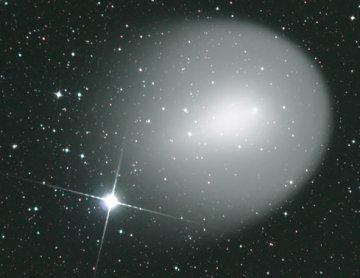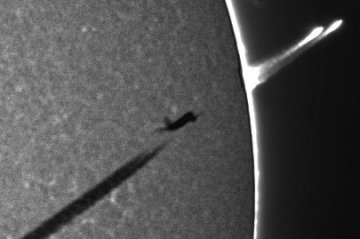 Where's Saturn? Is that a UFO--or the ISS? What's the name of that star? Get the answers from mySKY--a fun new astronomy helper from Meade. Where's Saturn? Is that a UFO--or the ISS? What's the name of that star? Get the answers from mySKY--a fun new astronomy helper from Meade. SPACE STATION MOVIE: On Nov. 16th, the International Space Station flew over the Netherlands where Ralf Vandebergh was waiting with his 10-inch telescope and a video camera: movie. "Note how one of the solar arrays is not tracking the sun," says Vandebergh. This is caused by a stuck rotary joint--an unsolved problem for the under-construction station. Anyone with a telescope can see this kind of detail when the station flies overhead; the trick is knowing when to look. BEWARE THE JELLYFISH: Comet 17P/Holmes is swallowing a star! Not really, but it looks that way. Tonight, Comet Holmes is passing directly in front of Mirfak, the brightest star of the constellation Perseus. Carlos Reis of Portugal took this picture of the converging pair on Nov. 18th: 
Photo details: Orion 80ED, Canon 350D,120s, ISO 1600
Readers liken the view through a backyard telescope to a giant space-faring jellyfish gobbling a phosphorescent treat. Although Comet Holmes is now fading to the limits of naked-eye visibility, the star-comet duo is still easy to find in the northern sky after sunset: sky map. Point your telescope and enjoy the meal. Comet 17P/Holmes Photo Gallery
[Interactive World Map of Comet Photos]
[sky map] [ephemeris] [3D orbit] [Night Sky Cameras] AIR PROMINENCE: When solar activity is low, what does a solar astronomer do? Wait for an airplane! During the weekend, astronomers at the Pic du Midi observatory in France were photographing the quiet sun when a jet liner flew by to break the monotony: 
Photo credit: Jean-Louis Levieil, Michel Pujol, Pic du Midi CLIMSO coronagraph
This composite image shows the plane when it was crossing in front of the sun and a moment later when it was past the edge. "At first we thought there was an eruption on the limb," says Pic du Midi software engineer David Romeuf. But it was just sunlight shining through the jet's turbulent contrail. The sun is quiet again. Fortunately, says Romeuf, "we get lots of planes." | 
